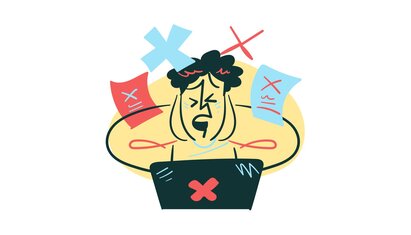ICD-10 code for panic disorder

Published October 13, 2025

If you’re in need of the psychosis ICD-10 code, this article includes a list of codes for psychotic disorders.
Using the right ICD-10 code for mental health conditions is an essential part of clinical practice, helping you avoid insurance delays and streamline billing.
This article provides an overview of the ICD-10 code for psychosis, along with diagnostic criteria, differential diagnoses, and other important codes you may encounter.
Bookmark this article as a reference to use next time you need to access the ICD-10 code for psychosis.
The International Classification of Diseases (ICD-10) is a clinical guide published by the World Health Organization (WHO) that contains standard diagnostic language for medical and mental health conditions. Using standardized language helps public health statisticians to identify and report health and disease trends globally.
However, clinicians in the United States (U.S.) commonly use the ICD-10-CM, which is the clinical modification of the WHO guide. The CM version contains greater specificity required by the Centers for Disease Control and Prevention and for insurance purposes.
In addition, mental health clinicians use the Diagnostic and Statistical Manual of Mental Health Disorders (DSM-5), published by the American Psychiatric Association (APA). The DSM-5 cross-references many relevant ICD-10-CM codes.
The main purpose of using ICD-10 codes is to accurately record a diagnosis, tailor a treatment plan, and seek insurance reimbursement.
The psychosis ICD-10 code falls under the section “Mental, behavioral, and neurodevelopmental disorders” (F01 to F99), and the sub-section “Schizophrenia, schizotypal, delusional, and other non-mood psychotic disorders (F20-F29).
In this section, you’ll find the codes for brief or acute psychosis ICD-10 and the unspecified psychosis ICD-10 code.
The major ICD-10 codes for psychosis and other psychotic disorders are:
Schizophrenia (F20)
Schizotypal disorder (F21)
Delusional disorders (F22)
Brief psychotic disorder (F23)
Shared psychotic disorder (F24)
Schizoaffective disorders (F25)
Other psychotic disorders not due to a substance or known physiological condition (F28)
Unspecified psychosis not due to a substance or known physiological condition (F29 diagnosis code)
These codes typically have additional, more specific diagnoses listed under each diagnostic heading.
For instance, if you are looking for the schizophrenia unspecified ICD-10 code, you would look under the F20 diagnosis code for more specific diagnosis and diagnostic criteria, including schizophreniform disorder (F20.81), other schizophrenia (F20.89), and schizophrenia, unspecified (F20.9).
The unspecified psychotic disorder ICD-10 code may fall under the F29 code, but it depends on the client’s symptoms.
There are more detailed diagnostic criteria for each of these disorders in the DSM-5 as well.
The diagnostic criteria for psychosis covers a range of symptoms depending on the specific condition.
In the DSM-5, these are grouped under schizophrenia and other psychotic disorders.
Key features defining psychotic disorders include:
Delusions: Fixed beliefs that are not based in reality and are resistant to change, even in light of conflicting evidence.
Hallucinations: Vivid sensory experiences that occur without external stimuli, such as seeing or hearing things that don’t exist.
Disorganized thinking: Difficulty staying on topic, which may affect coherent speech.
Grossly disorganized speech or abnormal motor behavior: This may look like childlike silliness, unpredictable agitation, or significant reductions in motor activity (catatonia).
Negative symptoms: Diminished emotional expression, reduction in speech output (alogia), reduction in motivated, purposeful activities (avolition), and reduction in the experience of pleasure (anhedonia).
While some clients may meet some of the criteria for psychotic or schizoaffective disorders, there may be a more appropriate diagnosis to consider, such as:
Delirium and major or mild neurocognitive disorder
Substance intoxication or substance withdrawal
Bipolar or depressive disorders
Obsessive compulsive disorder
Body dysmorphic disorder
Autism spectrum disorder
Malingering and factitious disorders
You can find more specific criteria (and specifiers) for disorders in this category under each diagnosis, including:
Delusional disorder (F22)
Brief psychotic disorder (F23)
Schizophreniform disorder (F20.81)
Schizophrenia, unspecified (F20.9)
Schizoaffective disorder (e.g., F25.0 for bipolar type, F25.1 for depressive type)
Substance/medication-induced psychotic disorder (codes from F10.159 to F19.959 depending on the substance and level of use).
Psychotic disorder due to another medical condition:
With hallucinations (F06.0)
With delusions (F06.2)
Catatonic disorder due to known physiological condition (F06.1)
Other specified schizophrenia spectrum and other psychotic disorder (F28)
Unspecified schizophrenia spectrum and other psychotic disorder (F29)
The full list of ICD-10 codes are available in digital and book formats:
ICD-10-CM Data, a searchable ICD-10 database: The psychosis ICD-10 codes are found under the section “Schizophrenia, schizotypal, delusional, and other non-mood psychotic disorders (F20-F29)
DSM-5 in the textbook and digital version
A critical note for clinicians: While the DSM-5 is a primary diagnostic reference, it does not frequently update its printed codes. The ICD-10-CM is regularly updated, and codes may not align with the most recent version. Always verify the most current ICD-10-CM code via an official database or resource before submitting claims to ensure accuracy and avoid payment delays.
SimplePractice is HIPAA-compliant practice management software with everything you need to run your practice built into the platform—from booking and scheduling to insurance and client billing.
If you’ve been considering switching to an EHR system, SimplePractice empowers you to run a fully paperless practice—so you get more time for the things that matter most to you.
Try SimplePractice free for 30 days. No credit card required.
Proudly made in Santa Monica, CA © 2025 SimplePractice, LLC
Proudly made in Santa Monica, CA © 2025
SimplePractice, LLC